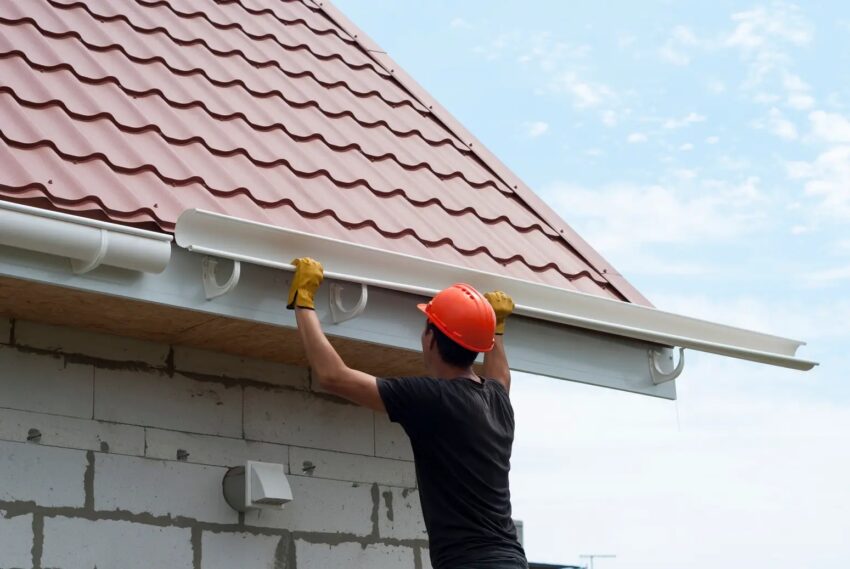Gutter installation in the USA costs approximately $10 per linear foot, with most homeowners paying anywhere from $1,000 to $6,600 for the entire job. Prices vary depending on the size of your home, the quality of materials, and installation labor costs. We’ll help you decide whether your home could benefit from installing or replacing guttering, including the cost of installation, money-saving tips, and answers to FAQs.
Factors in Calculating Costs of Gutter Installation
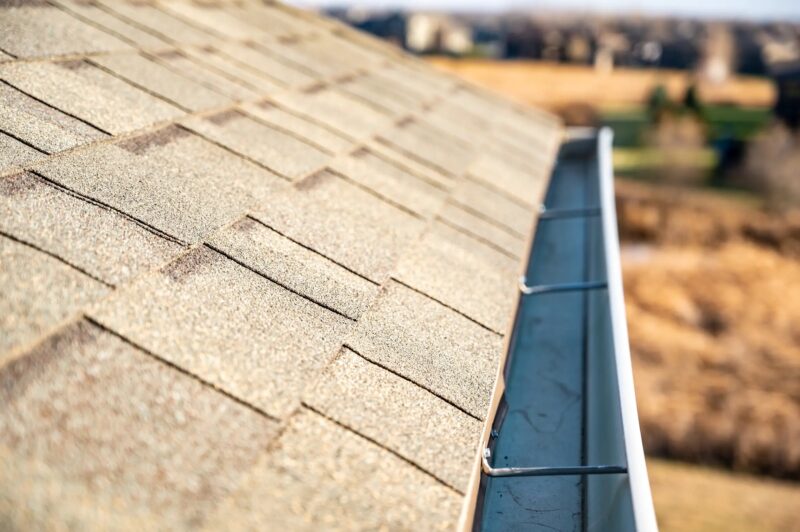
Several factors influence the cost of gutter installation, including the quality of the materials and the size of your home.
Gutter Material and Quality
Gutters are made from various materials, and prices vary considerably. The least expensive gutter material is vinyl or PVC, and the most expensive is copper. Another factor that influences new eavestrough cost is the quality, or grade, of the materials.
Linear Footage of Gutters Needed
Gutter installation is typically quoted by the linear foot. The average cost of gutters is $10 per linear foot.
For most homes, you can calculate how many linear feet of gutters you need by taking the square feet of the home and dividing it by 10. For example, if your home is 1,000 square feet, you’ll need about 100 linear feet.
Roof Complexity and Design
Complex roof designs require more components, like fittings, elbows, and downspouts, which will increase the cost of gutter installation. Also, the more complex your architectural design is, the longer it will take to install.
Labor Costs and Installation Complexity
On average, labor costs for gutter installation are about $6 to $9 per linear foot, but it varies depending on several factors, including design complexity, regional labor markets, and site accessibility.
For example, the cost to replace gutters on a 2-story house will be higher. Remember to research contractors accordingly as cheap gutter installation can indicate the installer’s skill level is lower.
Additional Components and Accessories
Gutter systems can be enhanced with various components and accessories to improve their appearance and functionality. Added features like heat tape, which costs $1 to $10 per linear foot, and splash blocks, which cost about $10 to $15 each, increase installation costs.
Advanced stormwater management systems for your home can include features like catch basins, swales, retention ponds, and rain barrels.
Cost of Gutter Installation Per Foot
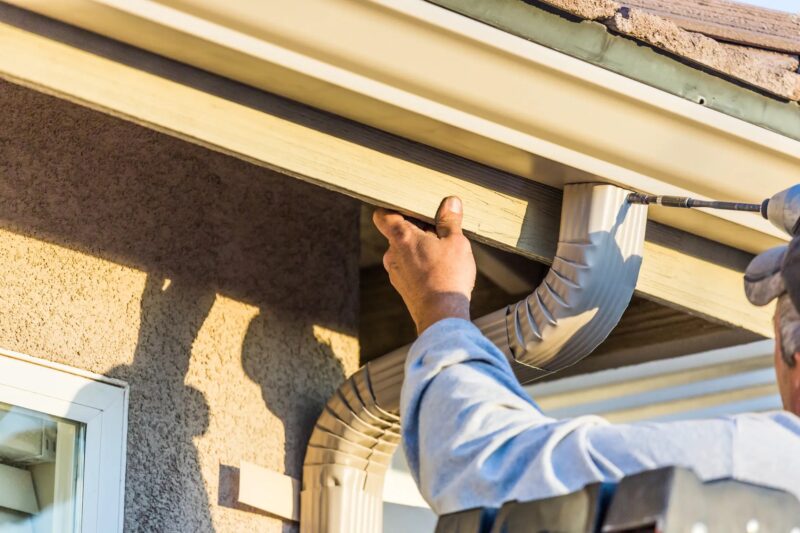
When calculating the cost of gutter installation per foot, getting an estimate using national averages is helpful. However, a few factors significantly affect these figures, such as gutter size and regional price differences.
Average Cost Per Linear Foot for Common Gutter Materials
The price of materials affects the average cost of replacing gutters. Here are the prices of the most common types, including installation.
| Gutter material | Average cost per linear foot |
| Vinyl (PVC) | $7 to $8 |
| Aluminum | $8 to $10 |
| Galvanized steel | $9 to $12 |
| Zinc | $12 to $30 |
| Copper | $16 to $32 |
Cost Variation Based on Gutter Size (5-inch vs. 6-inch)
The cost difference between 5-inch and 6-inch gutters averages about $0.50 to $1.00 per linear foot. Of course, the cost of 6-inch gutters can be much higher with more expensive materials. Since they can handle about 50% more water flow than 5-inch gutters, they are the best choice for areas with heavy rainfall.
Regional Price Differences
Several factors influence regional prices, lowering or raising your gutter installation costs. The local economy and cost of living are primary factors in local wage rates, but you may also pay more or less for installation due to building regulations, steep terrain, accessibility, and competition among contractors.
Additional Gutter Installation Costs and Considerations
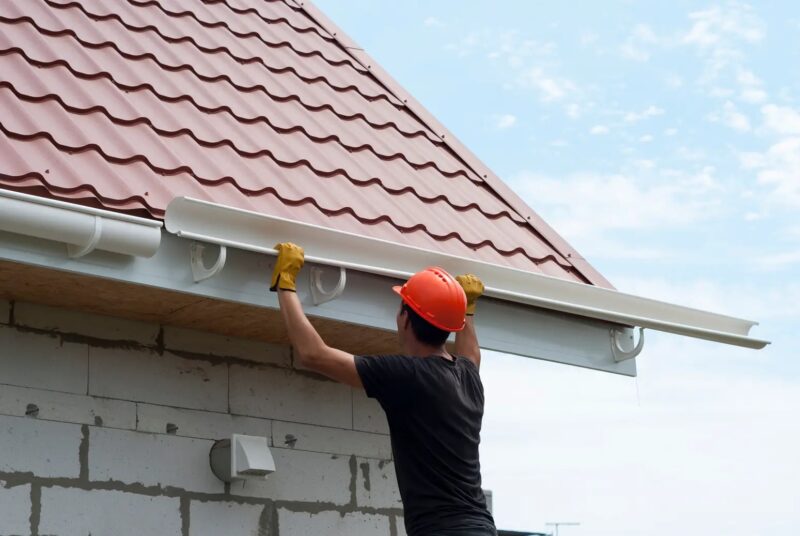
Gutter Downspout Costs
The cost to add gutters to a house includes downspouts, the vertical components that carry water away from your home to the ground below. Without downspouts, your gutter system may not protect your house and landscape effectively.
Downspouts cost $4 to $15 per linear foot. Rain chains are a decorative alternative, ranging in price from $50 to $250 each.
Gutter Guards and Covers
Clogged gutters are a problem for many homeowners, and gutter guards and covers are the easiest way to combat this issue. They prevent leaves and debris from getting into your gutters, making them easier to clean.
However, gutter guards aren’t foolproof. You’ll still have to inspect and clean your guards at least twice a year. The average cost of gutter guards is $5 to $10 per linear foot.
Removal and Disposal of Old Gutters
Removing old gutters can cost anywhere from $40 to $200. Before disposing of them, consider ways to reuse and upcycle them by turning them into herb planters or cord organizers. You can also lower your disposal costs and keep them out of landfills by taking them to building recycling centers.
Permits and Licensing
Depending on where you live, you may need a permit. In some states, you are even required to have your gutters installed by a licensed contractor.
Gutter Types and Prices
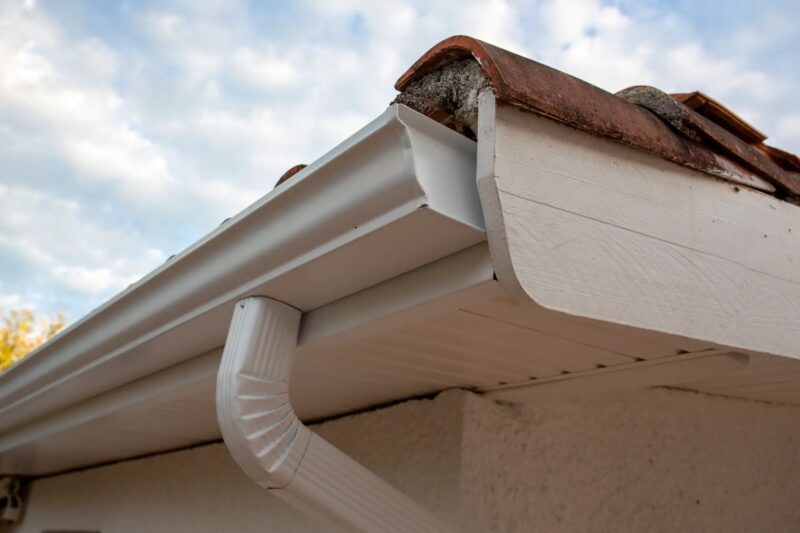
Gutter systems cost an average of $10 per linear foot. The type of material you choose will significantly impact the price.
Different Gutter Material Options
| Gutter material | Gutter material cost per linear foot | Total cost for 2,000 square foot home |
| Vinyl (PVC) | $7 to $8 | $1,400 to $1,600 |
| Aluminum | $8 to $10 | $1,600 to $2,000 |
| Galvanized steel | $9 to $12 | $1,800 to $2,400 |
| Zinc | $12 to $30 | $2,400 to $6,000 |
| Copper | $16 to $32 | $3,200 to $6,400 |
Pros and Cons of Each Gutter Material
Cost-effective gutter materials like vinyl and aluminum make new installations affordable for many homeowners. However, pricier options like zinc and copper offer a better aesthetic and longer lifespan.
Here are the pros and cons of various materials:
| Gutter material | Pros | Cons |
| Vinyl (PVC) | Affordable, lightweight, low maintenance | Less durable |
| Aluminum | Lightweight, corrosion resistant, available in a wide range of colors | Less durable, prone to denting |
| Galvanized steel | Durable, can be painted any color | Heavier, more expensive, may rust |
| Zinc | Aesthetically pleasing, durable, long-lasting | Expensive, harder to install |
| Copper | Attractive, durable, low-maintenance | Expensive, harder to install |
DIY Gutter Installation vs. Hiring a Professional
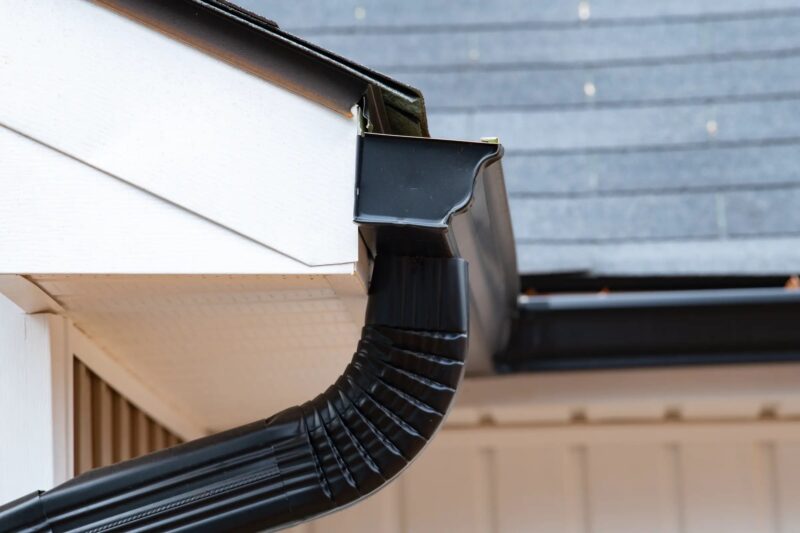
Most of the cost per linear foot for rain gutters is due to labor costs, so DIY installation is a great way to save money.
Factors to Consider When Choosing DIY or Professional Installation
When choosing between DIY and professional installation, consider the following factors:
- Your budget
- Your skill level
- Time constraints
- Complexity of installation
- Product warranties
Advantages and Risks of DIY Gutter Installation
DIY costs much less, but there are pros and cons. One of the advantages is that you can work on them when you want. Many people also prefer DIY installations because of the personal satisfaction it gives them.
On the other hand, some materials, like copper and zinc, are expensive and hard to work with, and professional installation may be a better choice.
How to Save Money on Gutter Installation
Getting Multiple Quotes
Obtain at least three quotes from reputable contractors in your area. This allows you to compare prices and negotiate a lower rate.
Exploring Financing Options
Before using your personal credit card to finance your gutter installation, check out the advantages of taking out a home equity line of credit. You can also consider refinancing your mortgage.
Seasonal Discounts and Promotions
Search for discounts and promotions on gutter installation. Some companies offer discounts to customers who schedule their installations in advance.
Maintaining Your Gutters to Extend Their Lifespan
The rule of thumb is to clean your gutters twice a year, in the spring and fall. This allows you to inspect them and make timely repairs, ensuring they last as long as possible.
When You Should Install or Replace Guttering
Each square foot of your roof catches 0.6 gallons of water per inch of rainfall. That means that one storm can deliver hundreds of gallons of water to the ground around your home, potentially damaging your home’s foundation and causing excess moisture in your basement, making gutters extremely important to the structure of your home.
Signs That Your Gutters Need Replacement
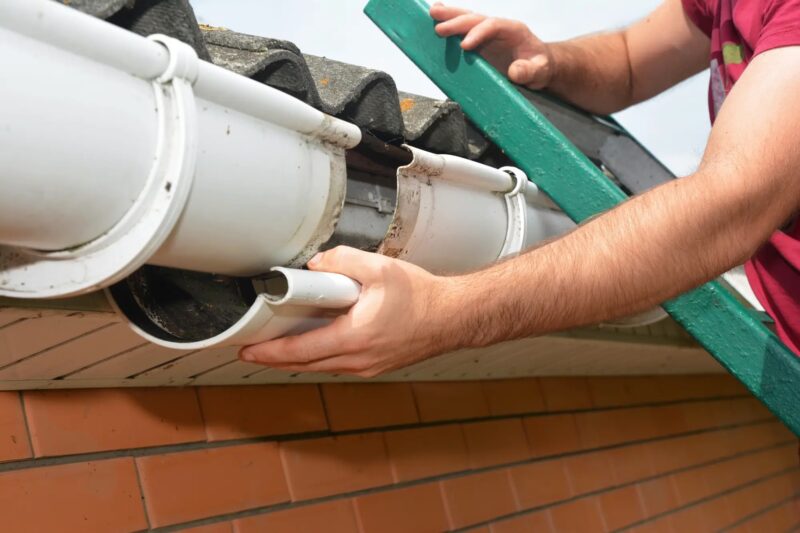
Gutters are susceptible to damage due to debris buildup and freeze-and-thaw cycles and may need frequent maintenance. Most gutters last about 20 years, but high-quality gutters can last up to 50 years or more.
Here are some signs that it’s time to replace your gutters:
- Visible cracks, splits, or gaps
- Rust
- Peeling paint
- Frequent clogs and overflows
- Sagging
- Material deterioration
- Pools of water around your house
- Water damage on your home’s exterior
Seasonal Considerations for Gutter Installation
For obvious reasons, you should avoid wet, rainy seasons for gutter installation. Summer is a popular time to install gutters because the weather is nice, but fall is best since you already have to clean your gutters before winter.
Benefits of Timely Gutter Installation
Failure to repair or replace your gutters in a timely manner can lead to a variety of problems, including the following:
- Foundation damage
- Basement flooding
- Erosion of landscape
- Roof damage
- Siding damage
- Wood rot and decay
- Pest infestations
The Benefits of Installing Guttering
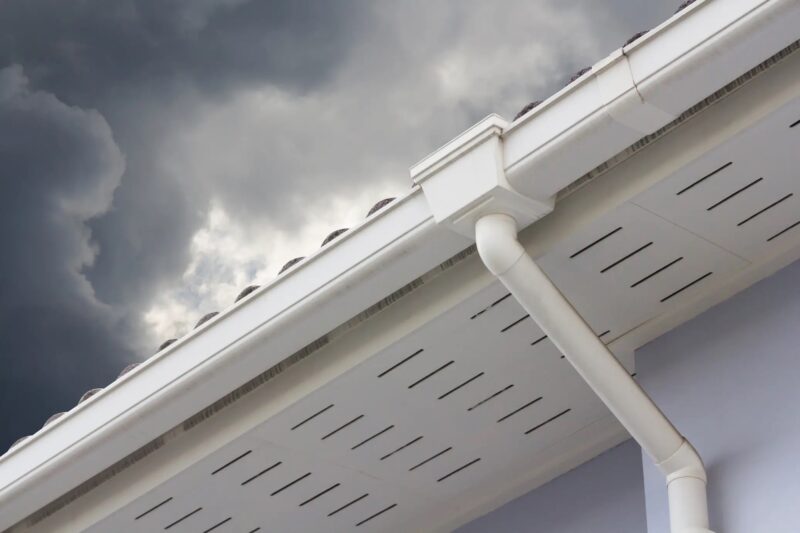
Protecting Your Home’s Foundation
When water pools around your home’s foundation, it creates hydrostatic pressure, which can cause a push-pull effect that weakens the structure of your home’s footings. This pressure leads to soil erosion, foundation settling, and cracks. Foundation damage can be prevented by directing water flow from your roof to a stormwater drainage system, away from the home’s foundation.
Preventing Water Damage
Standing water around your home’s foundation can leak into your basement or crawl space, creating the perfect conditions to support mold and mildew growth. Water damage can also occur on the exterior of your home if your gutters are missing or broken. Prolonged water flow can deteriorate your siding, fascia, and soffits.
Enhancing Curb Appeal
A meticulously installed gutter system can enhance your home’s curb appeal. When properly aligned and attached, your gutters look polished and contribute to the aesthetic of your home.
Additionally, without gutters, your landscape will suffer from the effects of erosion. Whether it’s a drip line under your eaves or dirt splashed around the base of your home’s exterior, these problems detract from the beauty of your home.
Increasing Property Value
Gutters are considered standard, especially in moist climates, and while they don’t necessarily add value to your property, they may attract buyers.
Good gutters are beneficial if you’re selling or refinancing, the cost to install gutters can be subtracted from your home’s property value.
5 FAQs About the Costs of Installing Gutters
FAQ 1: How Much Do Gutters Cost on Average?
Gutter installation costs an average of $10 per linear foot, ranging from $4 to $30. Rain gutters cost about $800 to $6,000 for most homes.
FAQ 2: What Is the Cost Difference Between 5-inch and 6-inch Gutters?
The average price difference between 5 and 6-inch gutters is about $0.50 to $1.00 per linear foot. A 2,000-square-foot home would have an average of 200 linear feet, costing $100 to $200 more for 6-inch gutters.
FAQ 3: Is Gutter Installation DIY-Friendly?
Gutter installation is more complicated than you might think, but if you’re an experienced DIYer, you can handle this project as long as you have someone to assist you with the lengthy pieces.
FAQ 4: Can I Save Money on Gutter Installation by Reusing Old Gutters?
You may be able to reuse your old gutters as long as they aren’t broken or damaged, but if you need to replace part of them, it can impact the visual appeal of your home if they’re mismatched.
FAQ 5: Are Gutter Guards Worth the Additional Cost?
Clogged gutters can lead to problems like water damage and pest infestations, which can cause damage. If you have a lot of trees near your home, gutter guards can help prevent a variety of problems, such as clogged downspouts, ice dams, and the need for frequent cleaning.

